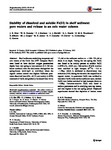Stability of dissolved and soluble Fe(II) in shelf sediment pore waters and release to an oxic water column
| dc.contributor.author | Klar, JK | en |
| dc.contributor.author | Homoky, WB | en |
| dc.contributor.author | Statham, PJ | en |
| dc.contributor.author | Birchill, AJ | en |
| dc.contributor.author | Harris, EL | en |
| dc.contributor.author | Woodward, EMS | en |
| dc.contributor.author | Silburn, B | en |
| dc.contributor.author | Cooper, MJ | en |
| dc.contributor.author | James, RH | en |
| dc.contributor.author | Connelly, DP | en |
| dc.contributor.author | Chever, F | en |
| dc.contributor.author | Lichtschlag, A | en |
| dc.contributor.author | Graves, C | en |
| dc.date.accessioned | 2021-09-28T09:39:35Z | |
| dc.date.available | 2021-09-28T09:39:35Z | |
| dc.date.issued | 2017-02-27 | en |
| dc.identifier.issn | 0168-2563 | en |
| dc.identifier.uri | http://hdl.handle.net/10026.1/17956 | |
| dc.description.abstract |
Shelf sediments underlying temperate and oxic waters of the Celtic Sea (NW European Shelf) were found to have shallow oxygen penetrations depths from late spring to late summer (2.2-5.8 mm below seafloor) with the shallowest during/after the spring-bloom (mid-April to mid-May) when the organic carbon content was highest. Sediment porewater dissolved iron (dFe, <0.15 µm) mainly (>85%) consisted of Fe(II) and gradually increased from 0.4 to 15 μM at the sediment surface to ~100-170 µM at about 6 cm depth. During the late spring this Fe(II) was found to be mainly present as soluble Fe(II) (>85% sFe, <0.02 µm). Sub-surface dFe(II) maxima were enriched in light isotopes (δ56Fe -2.0 to -1.5‰), which is attributed to dissimilatory iron reduction (DIR) during the bacterial decomposition of organic matter. As porewater Fe(II) was oxidised to insoluble Fe(III) in the surface sediment layer, residual Fe(II) was further enriched in light isotopes (down to -3.0‰). Ferrozine-reactive Fe(II) was found in surface porewaters and in overlying core top waters, and was highest in the late spring period. Shipboard experiments showed that depletion of bottom water oxygen in late spring can lead to a substantial release of Fe(II). Reoxygenation of bottom water caused this Fe(II) to be rapidly lost from solution, but residual dFe(II) and dFe(III) remained (12 and 33 nM) after >7 h. Iron(II) oxidation experiments in core top and bottom waters also showed removal from solution but at rates up to 5-times slower than predicted from theoretical reaction kinetics. These data imply the presence of ligands capable of complexing Fe(II) and supressing oxidation. The lower oxidation rate allows more time for the diffusion of Fe(II) from the sediments into the overlying water column. Modelling indicates significant diffusive fluxes of Fe(II) (on the order of 23-31 µmol m-2 day-1) are possible during late spring when oxygen penetration depths are shallow, and pore water Fe(II) concentrations are highest. In the water column this stabilised Fe(II) will gradually be oxidised and become part of the dFe(III) pool. Thus oxic continental shelves can supply dFe to the water column, which is enhanced during a small period of the year after phytoplankton bloom events when organic matter is transferred to the seafloor. This input is based on conservative assumptions for solute exchange (diffusion-reaction), whereas (bio)physical advection and resuspension events are likely to accelerate these solute exchanges in shelf-seas. | |
| dc.format.extent | 49 - 67 | en |
| dc.language | en | en |
| dc.language.iso | en | en |
| dc.publisher | Springer Science and Business Media LLC | en |
| dc.title | Stability of dissolved and soluble Fe(II) in shelf sediment pore waters and release to an oxic water column | en |
| dc.type | Journal Article | |
| plymouth.issue | 1-2 | en |
| plymouth.volume | 135 | en |
| plymouth.journal | Biogeochemistry | en |
| dc.identifier.doi | 10.1007/s10533-017-0309-x | en |
| plymouth.organisational-group | /Plymouth | |
| plymouth.organisational-group | /Plymouth/Faculty of Science and Engineering | |
| dcterms.dateAccepted | 2017-02-06 | en |
| dc.rights.embargodate | 2021-09-29 | en |
| dc.identifier.eissn | 1573-515X | en |
| dc.rights.embargoperiod | Not known | en |
| rioxxterms.versionofrecord | 10.1007/s10533-017-0309-x | en |
| rioxxterms.licenseref.uri | http://www.rioxx.net/licenses/all-rights-reserved | en |
| rioxxterms.licenseref.startdate | 2017-02-27 | en |
| rioxxterms.type | Journal Article/Review | en |
| plymouth.funder | Shelf sources of iron to the ocean::NERC | en |


